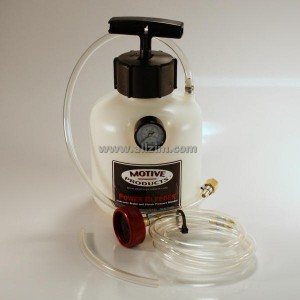Seeking sage advice, as I am finally admitting defeat somewhat. I have read over and over all articles on bleeding, from here and all the part site tech articles. As one should. But, I am stumped.
First, I have a 1976 2.0. I lost 2nd gear (I should say it welded itself onto the shaft), so with the help of Dr. Evil's dvds, got that tranny rebuilt, and then moved houses. For the last 3 years, the car has sat up on blocks, as I slowly between health issues rebuilt the entire suspension, steering gear, shocks, etc.
All 4 calipers were gone thru, the rears being totally rebuilt. Also in is a new 19mm master cylinder from 914 Rubber. I say this, as, well the car has been undriven for 3 years. (hey, I have turned it over and sat in it monthly, with sunglasses on, and a beer). (I have also continually checked for caliper leaks, drips, and anything coming from the MC. Nothing)
So, with excitement, filled the brake fluid. First, I bled the left front lower bleeder, gently pushing the brake pedal. Filled fluid again, and used the Motive Speed bleeder. (which I thought is impressive, btw.) Right rear, bottom, then top bleeders, worked my way around the wheels in the correct order. (I should say here, I have triple checked the rear brake pad clearance, and it is spot on) I did this bleeding process about 4 times, overall.
Spongy pedal, not getting any firmness until more than 1/2 way down. Pump the brakes, I get a wee bit firmer, but it seems to fade ever so slowly.
Grabbed my father, and switched to him pumping and me bleeding, thinking a human touch would work. Twice around the car. Same. But, he did enjoy sitting in the car, although there was a slight issue getting him out. (He's 83, and well, while you can fall into these 914's, you really cant reverse that and fall out.)
Read some more. Located the brake proportioning valve, and glared at it. It looks like its been in a dusty barn for 30 years. With some reading advice, I gave it multiple gentle bangs or taps, whichever you prefer to hear. Back to bleeding, knowing this had to do the trick.
Nope. Pedal is still about 1/2 way down before I get firmness, and a little harder if I pump 2-3 times.
So here I am. I could bleed some more, but I think I am missing something. I do have the absolute clearest brake fluid in my lines on the West Coast, but I do not have firm brakes. Technically, to me it feels like a large bubble is somewhere, although I cannot get even the tinniest bubbles out of the system anymore.
I will likely hang under the car tonight, again checking all connections. (Brake fluid reservoir does not deplete, nor can I find any drips, but, hey, why not.)
As an old VW guy, we used to adjust the MC rod down by the brake pedal. Cant seem to find anything on that for the 914. 'Could' it be a faulty proportioning valve? Should I bang on it more, replace it, or rebuild it? (I dont know if such is possible for either option). Am I missing something in the bleeding process?
Basically, a full brake rebuild has left me with spongy brakes which I would say leave the car unsafe to drive.
Any thoughts would be greatly appreciated. I am no real hurry, because I also have to wrap my head around adjusting a newly built shifter onto the long rod, which has also got me in stitches. But that's another post
Thanks all - I wish someone tells me I have or am doing something wrong to get this remedied.

